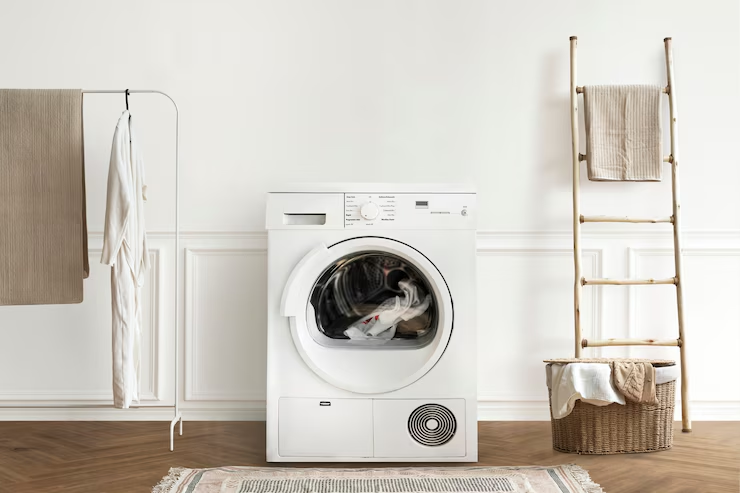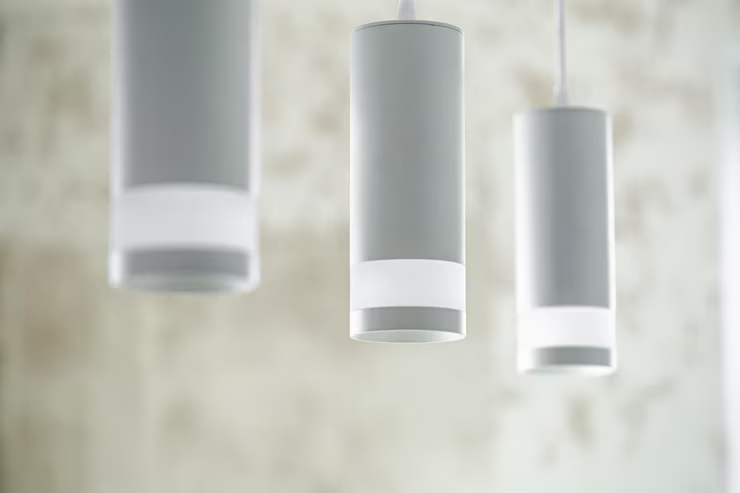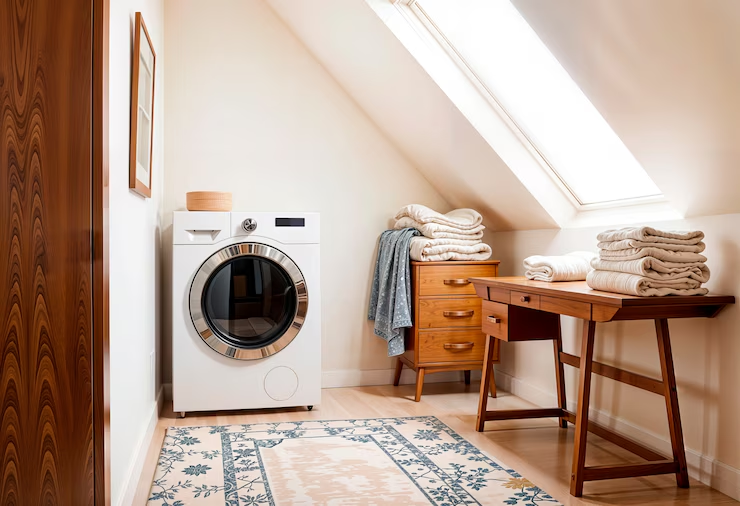I never thought much about laundry rooms until I found myself dealing with an incredibly small one. A washer and dryer squeezed into a dark corner, a few sad shelves overhead, and no room to fold, hang, or even breathe. All of this was enough to make laundry a dreaded chore.
But after experimenting, researching, and reimagining the space, I’ve discovered that even the tiniest laundry room can be made efficient, stylish, and surprisingly pleasant. If you’re like me and dealing with limited square footage, these design tips can help you transform your small laundry room into one of the most functional spaces in your home.

Think Vertical. Your Walls Are Gold
When I looked at my small laundry room, the floor plan felt cramped, but I realized I wasn’t using my vertical space at all. That’s when I started treating my walls like storage real estate. I installed floating shelves above the washer and dryer, added vertical cubbies for cleaning products, and even mounted a rod near the ceiling for hanging clothes.
Using the full height of the room helped me multiply the available storage without cluttering the floor, which made the entire room feel taller and more open.
Opt for Stockable Appliances
One of the best decisions I made was replacing my side-by-side washer and dryer with a stackable set. At first, I hesitated because I was used to folding clothes on top of the machines, but once I saw how much floor space I freed up, I never looked back.
That vertical configuration opened room for a slim cabinet on the side, giving me space to store laundry baskets, detergent, and even a fold-out ironing board. If your appliances are due for an upgrade, stackables are a small laundry room game-changer.
Install a Countertop Over Your Machines
When I did have side-by-side machines, I added a custom countertop over them, and it completely changed how I handled laundry. Suddenly, I had a flat, clean space for sorting, folding, and organizing.
Even if you go for a butcher block, laminate, or even a stone surface, a countertop adds both style and utility. If your machines are front-loading, this addition is practical and elegant, and it turns a purely functional area into a mini workspace.
Use Sliding or Pocket Doors
Traditional doors that swing open can eat up precious space, especially in tight quarters. In my case, the laundry room door used to swing right into the washer, which meant I had to step into the hallway just to load clothes.
Switching to a sliding barn door made a massive difference. Pocket doors are also a great option if you’re doing renovation, since they tuck neatly into the wall. Even a curtain or folding door can help reclaim room that a swing-out door would normally block.
Choose Light Colors and Reflective Surfaces
My original laundry room felt like a closet. It was small, dark, and a bit depressing. Simply repainting the walls a soft white and installing a glossy subway tile backsplash made the room feel twice as big.
Light colors bounce natural and artificial light around, helping the room appear more spacious. If you can’t paint, even lighter cabinets or peel-and-stick tiles can help create that airy effect. I added a mirror on the opposite wall to reflect more light, and it added both style and a sense of openness.

Add Task Lighting Where It Counts
Overhead lighting is essential, but small laundry rooms often lack focused illumination. I added under-shelf LED lights, which made folding clothes and reading detergent labels a lot easier.
Task lighting doesn’t have to be expensive because battery-powered puck lights or LED strips can be placed under the shelves or cabinets. this simple touch helps create a clean, functional atmosphere and eliminates the cave-like feel that small laundry spaces can sometimes have.
Keep It Clutter-Free with Hidden Storage
I used to keep laundry detergent, dryer sheets, bleach, and other supplies on an open shelf, and it always looked messy. Installing a cabinet with doors instantly made everything look more put-together.
I even use matching baskets inside to sort by function: cleaning, laundry, tools, and so on. Hidden storage allows you to keep what you need nearby without creating visual clutter, and that’s crucial in a compact space.
Customize with Built-Ins If You Can
When I tackled a mini-renovation, I had a carpenter build custom shelving around my machines. It wasn’t as expensive as I feared, and it allowed me to tailor every inch of space to my needs.
Custom built-ins maximize every nook and cranny, especially in awkward or narrow laundry rooms. Even a few floating shelves installed precisely where you need them can make a huge difference.
Upgrade Hardware and Fixtures
One subtle way I made my small laundry room feel more like a polished part of the house was by upgrading the hardware. I replaced builder-grade knobs with sleek matte black ones and switched out the faucet for a gooseneck version with a pull-down sprayer.
These small details made the space feel curated and intentional rather than forgotten. Even if you’re renting, swapping hardware can be a reversible upgrade that makes a huge difference.
Add a Small Sink If Space Allows
When I remodeled, I made room for a small utility sink, and it’s been one of the most useful additions. It doesn’t take up much room, but it gives me a place to soak stained items, hand-wash delicates, or clean up after gardening.
If plumbing allows, even a corner sink or a slim bar-style model can add serious function to a laundry room.
Use Hooks and Racks for Vertical Storage
I underestimated the power of a good hook until I ran out of shelf space. Now I hang everything from dusters and brooms to canvas laundry bags and drying hangers on hooks.
You can line a whole wall with pegboard for customizable storage or simply add a few well-placed hooks behind the door. It’s an efficient way to use often-ignored surfaces.
Use Open Storage Wisely
Open shelves can be both a blessing and a curse. They offer easy access and keep things visible, but they can quickly look chaotic if not styled properly.
I limited open shelving to the items I use daily, such as detergent, dryer sheets, and a lint bin, and placed them in coordinated containers. Everything else went behind closed doors. This balance allowed for convenience without sacrificing visual harmony.
Install a Drying Cabinet
If you air-dry a lot of clothes, a drying cabinet can be a sleek solution. While I couldn’t fit a full cabinet, I installed a pull-out drying rack inside one of my cabinets.
When I need it, it glides out smoothly. When I don’t, it vanishes completely. It’s ideal for drying clothes without cluttering the room with freestanding racks.

Go for Smart Appliances If You Can
Smart washers and dryers might sound like a luxury, but they’ve genuinely helped me make the laundry process easier. I get alerts when cycles finish, and I can schedule loads to start during off-peak hours.
Some models even have built-in sensors that adjust water usage automatically. In a small laundry room, efficiency is everything, and smart appliances help you make the most of every minute.
If you liked this article, here’s what to read next: Top 9 Design Ideas That Were Doomed from the Start